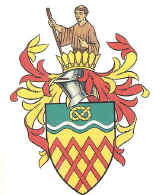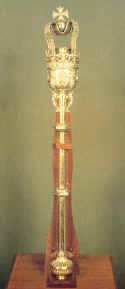Coat of Arms of the Borough
A new system of local administration was created in England and Wales in 1974 which altered the status of many existing local authorities. Following Local Government Reorganisation, some of the former local authorities, were amalgamated, some enlarged, but in the process, many previous authorities lost their identity.
In the case of the Borough of Stafford, for example, were added the Urban District of Stone and the Rural Districts of Stafford and Stone, to become a new district council. The Local Government Act 1972, provided for former dignities to be preserved and, upon application being made by petition, Queen Elizabeth II granted a Royal Charter, conferring the title of Borough on the District Council.
With effect from April 1974, former authorities absorbed by the substantial amalgamation, were no longer entitled legally to use armorial bearings previously borne, but were at liberty to apply to the College of Arms for a new grant and, as a result of such application, the arms depicted were granted to Stafford Borough Council.
The shield shows four red interlaced chevrones on a gold ground, signifying the four former local authorities now 'embraced' to comprise the new Borough. The livery colours are those of the Stafford family-gold, a red chevron. The green chief betokens the pastoral and agricultural nature of the area, dominated by a Stafford Knot in gold, whilst the narrow wavy silver band, following the contour of the chief, represents the river Trent which, flowing through the area, also marks the boundary between the two English Heraldic provinces of Norroy and Clarenceux.
The crest is the figure of St Bertelin, holding a staff, an allusion to the name of the town, issuing from a palisado crown in reference to Stafford Castle, formerly overlooking the town from the east. The first castle, built c 1069, was essentially an earth fortification with a stockade for defence, hence the 'palisado' crown in distinction to the more usual 'mural' crown adopted by some municipal authorities.
The legend of St Bertelin derives from the 14th century account of him by Capgrave in his 'Nova Legenda Anglie', retold by Dr Robert Plot in his 'Natural History of Staffordshire' (1686). He is reputed to have been the son of the Mercian prince, the friend and disciple of St Guthlac who, after St Guthlac's death c 700, continued his holy vocation on the islet of Betheney now Stafford. Here, he remained until forced to retreat from the ill-will of jealous detractors, when he repaired to Ilam, in Dovedale, Derbyshire where ultimately he died. His burial place in Ilam church was once a place of pilgrimage.
A chapel of Saxon origin, demolished in 1802, once stood attached to the west end of the Collegiate Church of St Mary. After the Dissolution, this building, long respected as St Bertelin's shrine, accommodated the old Grammar School and was used by the Borough Council for almost 200 years as their Council Chamber.
Some few years ago the chapel site was excavated and the Saxon foundations uncovered, together with an ancient wooden cross, thought to be the Saint's original preaching cross. A replica of this now reposes amid the early stones on the exact site where it was discovered.
In addition to arms, the College also granted the Borough a new Badge, on a red roundel the 'quadrangular castle in perspective, the four towers domes argent, each surmounted by a pennon gold' which formed the predominant charge on the former Borough's arms as recorded at the Heralds' Visitation 1614.
Mayoralty and Civic Regalia
The history of civic ceremony is as long as the history of local government in this country and reaches back to the very start of civilisation.
When the King James I Charter, dated 1614, gave the town its first Mayor, Stafford was already an ancient town, founded by Ethelfleda in 913.
Today we tend to take the Mayoralty for granted and assume that the chief citizen of the Borough will be received into office with all the splendour of civic ceremony, representing the Borough at all important occasions.
 But for two thirds of its history, Stafford had no Mayor. The struggle to create a Mayor of Stafford was a tale of intrigue, riots and snobbery. The creation of Mayor in the town was the aim of a group of people who were trying to keep government of the town in the hands of 'a better type of person'.
But for two thirds of its history, Stafford had no Mayor. The struggle to create a Mayor of Stafford was a tale of intrigue, riots and snobbery. The creation of Mayor in the town was the aim of a group of people who were trying to keep government of the town in the hands of 'a better type of person'.
This naturally aroused the concern of a good many people, and it was only after a good deal of quarrelling and rioting that a Mayoral Charter was granted by James I. One of the men who played an important part in trying to obtain the charter was Matthew Craddock junior, who eventually rewarded himself by becoming the first Mayor of Stafford. The name Craddock is very important in Stafford's civic history. It provides a direct link between the two forms of government before and after the charter.
Matthew Craddock's grandfather known as Matthew Craddock senior, was six times bailiff between 1549 and 1584 and was in office when Queen Elizabeth I visited the town in 1575. Matthew Craddock junior was said to have been a strong willed man and was prepared to go to extremes to get his own way. Apart from being Mayor, he served as Member of Parliament on four occasions during the 1620's. On the Mayoralty being established in Stafford, it took another 318 years before tradition was broken and the town had its first Lady Mayor, Councillor Mrs E M South in 1932. Since then there have been several lady Mayors. The longest serving Mayor was Mr Walter C T Mynors who held office for five years from 1897 to 1901 but the record is not likely to be broken because since 1959 Mayors have held office for one year only.
 The insignia of Stafford Borough consists of four maces: the Great Mace, Collingwood Mace and two ancient Silver Maces plus a Mayor's chain and badge and Mayoress's chain. The Great Mace is of silver gilt, forty-two inches long, and its shaft is divided into three lengths by massive bands. The emblems, round the head, or bowl, are divided from each other by demi-figures and arabesque ornaments, and consist of a rose surmounted by a crown, and enclosed is an oval tablet; the former arms of the town (on a chevron the Stafford Knot) similarly enclosed; a thistle crowned and enclosed in the same manner as the rose, and the arms repeated. The head is crested with a circlet of crosses patthe and fleurs-de-lis, alternated with balls, from which rise the arches of the open crown, surmounted with orb and cross. The Mace bears the inscription '1655, this mace was made by Master Thomas Backhouse ironmonger, being Maior of Stafford'.
The insignia of Stafford Borough consists of four maces: the Great Mace, Collingwood Mace and two ancient Silver Maces plus a Mayor's chain and badge and Mayoress's chain. The Great Mace is of silver gilt, forty-two inches long, and its shaft is divided into three lengths by massive bands. The emblems, round the head, or bowl, are divided from each other by demi-figures and arabesque ornaments, and consist of a rose surmounted by a crown, and enclosed is an oval tablet; the former arms of the town (on a chevron the Stafford Knot) similarly enclosed; a thistle crowned and enclosed in the same manner as the rose, and the arms repeated. The head is crested with a circlet of crosses patthe and fleurs-de-lis, alternated with balls, from which rise the arches of the open crown, surmounted with orb and cross. The Mace bears the inscription '1655, this mace was made by Master Thomas Backhouse ironmonger, being Maior of Stafford'.
Tradition has it that when James I visited Stafford in 1617 he was so impressed with the Mace that he ordered 'it should never be allowed to rest' and Stafford is one of the few Boroughs which always places the Mace upright when used at council meetings and on ceremonial occasions. The following is an account of the visit of James I to Stafford in 1617 (in old English) :-
'The Maior kissed the mace and delivered it up to his Majesty, who having received the same did very seriouslie observe the forms thereof, for it was in outward shew as fair a mace as anie King then carried before him, yt had all the arms and coats of the Kingdom richlie wrought upon the gloabe, and it was of that beautye, and seemed to be of that worth, that Francis Dorrington had given forth divers time that it was too bigge, and that the King would take exceptions to yt. But thanks be to God, that scruple of conscience was removed, for the King did most graciously give the same back again to the Maior, enabling him thereby, as it were then by an actual possession, both to carry that mace and to exercise his former authority.'
In addition to this rather grandiose-looking Mace, there are two, much older, small silver maces which belonged to the two bailiffs of Stafford who administered the town before the office of Mayor was established.
The Council was presented with the 'Collingwood Mace' on the first anniversary of granting the Freedom of the Borough to H M S Collingwood in March 1979.
The Stafford Knot
 The origin of the Stafford Knot is shrouded in the mists of antiquity, but it can be said that the somewhat barbaric tale of a certain sheriff who invented it to hang three criminals with one rope at the same time, may be dismissed as an effort of the imagination.
The origin of the Stafford Knot is shrouded in the mists of antiquity, but it can be said that the somewhat barbaric tale of a certain sheriff who invented it to hang three criminals with one rope at the same time, may be dismissed as an effort of the imagination.
The earliest authentic appearance of the Stafford Knot is on the seal in the British Museum, and this was the property of Joan, Lady of Wake, who died childless in 1443.
Her personal possessions passed to her nephew, Humphrey, Earl of Stafford, who adopted the Knot of Rope, henceforward to be known as the Stafford Knot, as his badge, probably just preceding his creation as Duke of Buckingham in 1444. That he did adopt it from his Aunt is undoubted and she, being a direct descendent of Hereward the Wake, may have had it handed down to her from past generations, through many unknown but doubtless - romantic circumstances.
The Duke of Buckingham and his descendants used this Stafford Knot as personal cognizance. It did not form part of their armorial bearings, which were personal to themselves, but it was their badge and they gave the knot of rope to their retainers and servants as a livery and means of recognition.
The townsmen of Stafford were leigemen of the Stafford family, and as such also used this badge. As the days of feudalism passed and individual and civic liberties grew, it was gradually adopted by the Citizens, Freemen and Burgesses until ultimately it was included in the Borough Coat of Arms. Even following Local Government Reorganisation in 1974, the Stafford Knot still appears on the Coat of Arms of the new Stafford Borough.
